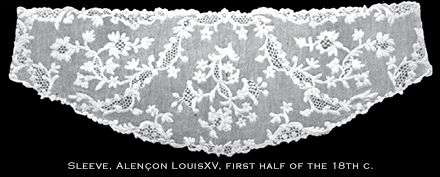ALENCON LACE HISTORY II
From 1760
The modes of Alencon, though very light, open, and effective, are not so rich and varied as those in Venise a reseau, or Brussels lace. Indeed, in 1761, a writer, describing the point de France, says that it does not arrive at the laste and delicacy of Brussels, and that the modes are inferior, and consequently much point is sent from Alencon to Brussels to have the modes added ; but connoisseurs, he adds, easily detect the difference. A favourite mode is the square trellis foundation, ornamented with circles at the points of intersection. Zigzag lines finely picoted are also used with effect. One of the modes, which consists of a button-hole stitched solid hexagon within a skeleton hexagon,and connected with the surrounding figure by means of six small ties or brides, is sometimes used extensively to form a groundwork, when it has been named by M. Dupont Auberville, "reseau rosace" (Argentella). This "Argentella" was supposed by Mrs Falliser to be of Genoese* workmanship, but it has no affinities with the type of lace made in Genoa, while its character and the style of the floral patterns are those of Alencon. Its cordonnetf is worked in button-hole stitches closely cast over a thread, which outlines various forms in the design —a distinctive mark of point d'Alencon. In general the laces distinguished as point d'Alencon, point d'Argentan, and Argentella have so many characteristics in common that it would be preferable to call them Alencon a reseau, Alencon a grandes brides, and Alencon a reseau rosace.

La brode, the next process, is worked in button-hole stitch, and gives relief to the design in the veining of the leaves, the stalks of the flowers, &c. The brode is borrowed by Alencon from raised Venetian point, but the relief is much lower in the French brode. To obtain the raised effect, a pad of coarse thread was laid down, and upon these very close button-hole stitches were worked. When this is completed, the threads which unite lace, parchment, and linen are cut by a sharp razor passed between the two folds of linen ; the loose threads are removed (enlevage and eboutage), the regaleuse repairs any small defects, and there remains one last process that of uniting all the segments of lace imperceptibly together, or the " assemblage." The seam follows as much as possible the outlines of the pattern. When finished, a steel instrument, the aficot, was passed into each flower to polish it and remove any inequalities on its surface. There are therefore twelve processes, including the design. These can be subdivided into twenty or. twenty-two.

In point d'Alenc.on horsehair was introduced to give firmness and consistency to the cordonnet in the later period of Louis XV., and during the reign of Louis XVI. It has been objected* that this cordonnet thickens when put into water, and that the horsehair edge draws up the flower from the ground, and makes it rigid and heavy. It was this solidity of Alencon, and of the still heavier Argentan which caused them to be known as " dentelles d'hiver,"f According to Peuchet, it was only worn in the winter, though at that date it was sufficiently light in design.
[n 1836 Baron Mercier, thinking by producing it at a lower price to procure a more favourable sale, set up a lace school, and caused I he girls to work the patterns on bobbin net, as bearing some resemblance to the old point de bride, but fashion did not favour point de bride, so the plan failed. The only important modern innovator in uorkmanship was the introduction of "shading" on the flowers by M. Beaume in 1855. Shaded tints were brought in tentatively by M. Larnaz Triboult, and in a book of patterns for point made between 1811 and 1814, certain leaves were marked to be shaded. This effect is made by varying the application of the two stitches used in making the flowers—the toile, which forms the closer tissue, and the grille, the more open part of the pattern. This system has been adopted in France, Belgium, and England, but with most success in France. The thread from which Alencon was made was spun at LilIe,J and also at Mechlin and Nouvion.
